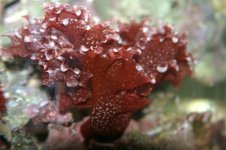You are using an out of date browser. It may not display this or other websites correctly.
You should upgrade or use an alternative browser.
You should upgrade or use an alternative browser.
best refugium macroalgae
- Thread starter Tangboy
- Start date
dizzy":1fmxv02d said:I don't believe it's either of your choices. Bob Fenner mentions something called Nitophyllum which is sometimes called Red Dictyota AKA red Y branch. See if you can find a picture of that.
Mitch
I don't think that's it.
http://www.saltcorner.com/sections/guest/algaepage/Red/reddictoya/Npunctatum.htm
Regards,
David Mohr
Boy i wished you lived closer i've give it to you, its hard for me since i'm disable.alfbennett":dnsxstlb said:Where is a good place online to pick up Chaetomorpha? Or if you feel like shipping your trimmings P.M. me, I will pay for shipping and some for your troublel.
_________________
Indian Forum
dizzy":j7vr4j5m said:John, I don't believe it's either of your choices.
That's ok. I'm still sticking with them.
FWIW, the photos I posted show single blades laid out flat (probably separated from a mass of blades like your growth). It is unlikely to find any perfect match between photos and you can see high variability across a genus when you look at the range. Anyone will tell you that many of the macroalgaes (esp. reds and browns) are extremely difficult to positively identify outside of a marine botany lab.
John_Brandt":1drachsq said:dizzy":1drachsq said:John, I don't believe it's either of your choices.
That's ok. I'm still sticking with them.
Well one thing is for certain. It can't be both of them. When I look at the pictures John posted I would say it looks more like Galaxaria than Gracilaria. The name Gracilaria means slender in latin. There are however (According to Fenner/Calfo) forty species of Gracilaria so maybe John just didn't find the right picture. This stuff doesn't have the V shaped stalk like the picture he posted shows. Calfo/Fenner say Galaxaura is Boneweed and it is heavily calcified. This stuff doesn't feel calcified, but there may be several species of Galaxaria as well. It certainly doesn't look anythin like the picture on p.100 of their Reef Invertebrates book. They also seem to agree more with David than with John when speaking of Dictyota they say "There are yellow-brown, purple and green-hued varities. I was thinking this stuff was rather common and the indentification would be more obvious. Don't write anything in stone just yet.
dizzy":yuid1q7d said:There are however (According to Fenner/Calfo) forty species of Gracilaria so maybe John just didn't find the right picture.
Which is why I only named genus for my guesses.
Gracilaria sp.

Gracilaria sp.

Nice Japanese image page with examples of Gracilaria: http://www.lib.kobe-u.ac.jp/directory/algae/e-kaba.html
dizzy":yuid1q7d said:Calfo/Fenner say Galaxaura is Boneweed and it is heavily calcified.
That doesn't appear to be universally true for that genus.
Galaxaura images: http://www.lib.kobe-u.ac.jp/directory/algae/e-gibo.html
dizzy":yuid1q7d said:They also seem to agree more with David than with John when speaking of Dictyota they say "There are yellow-brown, purple and green-hued varities.
Purple ain't red. The purple Dictyota I've seen is distinct.
Purple-ish Dictyota
dizzy":yuid1q7d said:Don't write anything in stone just yet.
Agreed.
dizzy":yuid1q7d said:Well I,m putting my money on Botryoglossum ruprechtianum. Want to bet JB?
Botryoglossum ruprechtianum
You might be right, but the references say that one is from the California coast. No bets please. But how could this be settled anyway?
John_Brandt":1biy1v99 said:dizzy":1biy1v99 said:There are however (According to Fenner/Calfo) forty species of Gracilaria so maybe John just didn't find the right picture.
Which is why I only named genus for my guesses.
Gracilaria sp.

Gracilaria sp.

Nice Japanese image page with examples of Gracilaria: http://www.lib.kobe-u.ac.jp/directory/algae/e-kaba.html
John,
It sure looks like the top photo of Gracilaria. You should have posted that one first.
All bets are off. :wink: BTW I think that the red algae in the other thread "Plant or animal" is actually Halymenia psuedofloresia and not H. floridana. Search the Smithsonian site.
Mitch
[
dizzy":2s34o8jx said:All bets are off. :wink: BTW I think that the red algae in the other thread "Plant or animal" is actually Halymenia psuedofloresia and not H. floridana. Search the Smithsonian site.
Yes, I have already seen the few images on their site. I cannot find an image of H. floridana on the Internet. It looks very much like your plant. But then, there's that variability problem. In most cases it's probably safest to just guess by genus.






